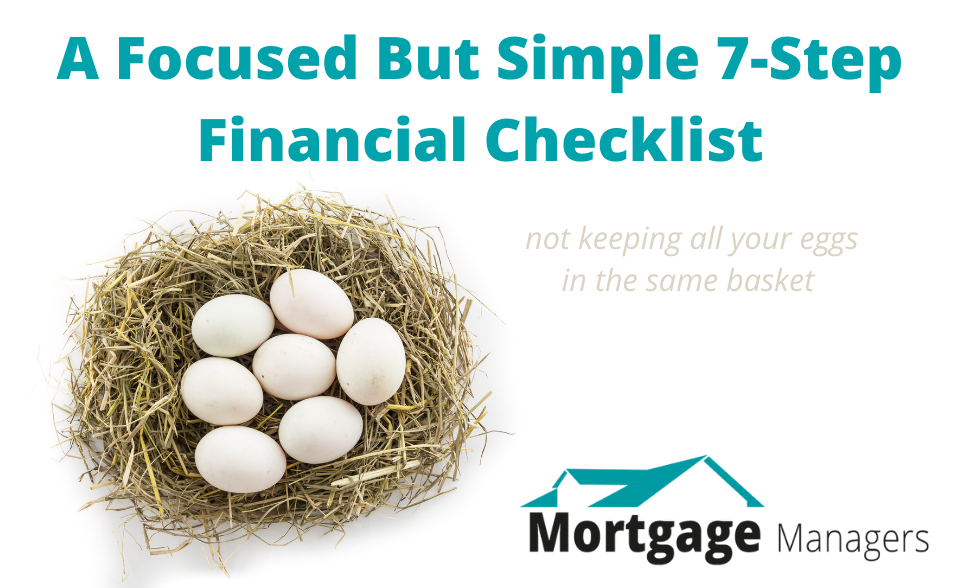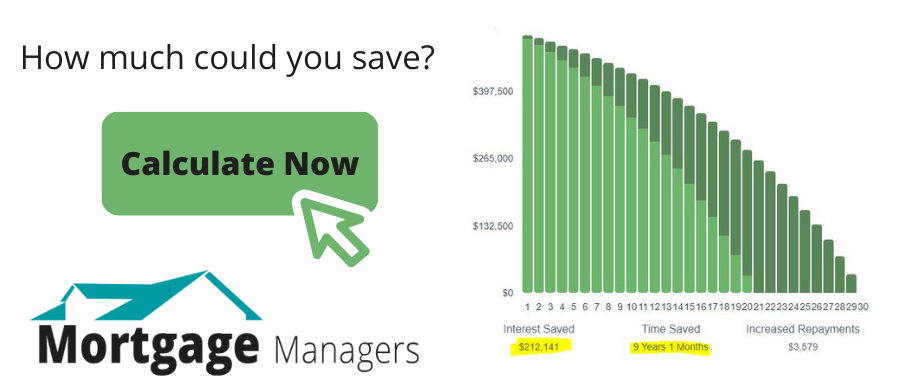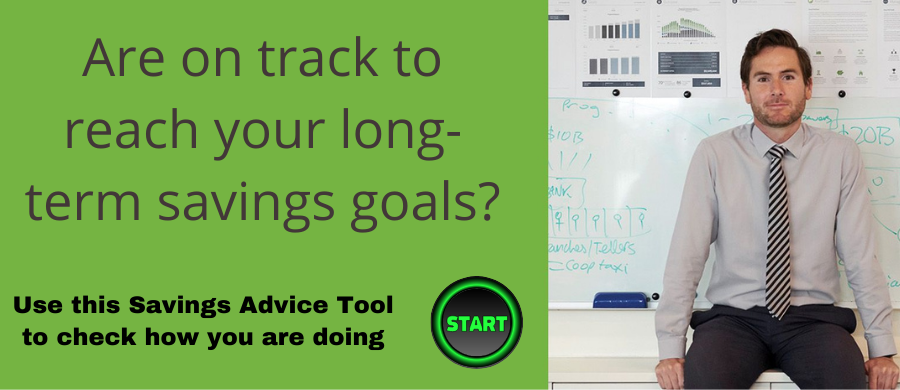As mortgage advisers we created this 7-step financial checklist to help you manage your financial affairs.
Most people think that we can only give advice and provide help with home loans; however there are a number of other areas that we can help with too.
When you complete a review of your financial affairs there is more than just the finance that should be considered. A complete review will look at your debts and how they are best managed, your risk management to ensure that you can manage the unexpected and of course your savings and investment which ensures that you are prepared for the future.
Here we look at the “typical agenda” that an adviser might use to stay focused when completing a review.
This is what we refer to as our focused but simple 7-step financial checklist.
The 7-steps are;
- Home Loans
- Insurances on Your Stuff (assets)
- Insurances on You (ability to earn and therefore cover expenses and commitments)
- Savings
- KiwiSaver (retirement savings)
- Other Investments
- Estate Planning
The key of this 7-step financial checklist is to make sure that you cover all of these areas even if some may seem important while others don’t.
Too often people will focus on just one area, when really these areas are all interlinked and a change to one of the steps will most likely mean that another should be changed too.
Some people will have less than 7-steps in their review process, and others may think that our 7-step financial checklist is too simple; however over the years it has proven to cover most things that should be considered and at least open up the conversation if other things may be needed.
1: Home Loans & Finance
![]()
This is the main reason that mortgage advisers exist – to give advice and help people source home loans.
A mortgage adviser used to be known as a mortgage broker and as such most people just used to use a broker to source the home loan. These days advisers are available to help source the mortgage, set the loans up to suit and then assist with maintaining the loans too.
When you review your home loan you should consider;
- Are you paying the loans off fast enough? A home loan is a large financial commitment (debt) and paying it off faster will save you a lot of money over the long term. You can use our mortgage calculator to see just how much you can save, but the important thing is to make a change and pay more than the minimum.
- Check that your loan structure allows you to manage the loans to suit – often we see the banks set things up so people have their lending as just one loan, and then any subsequent lending is set up as new loans. This may be the easiest for the bank staff to set up, but it doesn’t provide you with the flexibility that you deserve. Having a good loan structure is almost certainly the most important thing to do with your lending, and this may include reviewing what bank or loan option you choose too. While they may seem the same it’s important to understand that not all loans are created the same and this is an area where an adviser can add real value.
- Interest rates are important too. You want to ensure that you have competitive interest rates across all of your loans, and while it’s nice to have the lowest interest rate being offered at any point in time it’s not the most important thing. The various banks change interest rates often so while one bank may be cheaper today, tomorrow it may be a different bank so chasing the lowest rate is never really going to help.
When you are reviewing your home loan you should also consider any other debt or opportunities to get additional lending.
- Credit Cards – these can be useful, but if you do not pay them off in full each month then they can cost you a lot of money.
- Overdrafts – banks are very quick to give you a small overdraft and while it may seem useful it is often very expensive and generally not really needed. People will tend to use an overdraft if they have one but it’s not something that most people need and you are better to pay it off and get rid of it.
- Personal Loans – again, these are easy to get but generally quite expensive. It makes more sense to use the lower mortgage interest rates and use the savings to pay the loan off faster.
- Vehicle Loans – these vary a lot but generally they are more expensive than what the mortgage rates would be.
We also mentioned opportunities to get additional lending and this is something that people often do not consider. There are some good reasons to get more debt and those include getting money for business and investment purposes, like;
- Borrowing to invest – there are many investments that may offer higher returns than what it costs to borrow the money and therefore if you are comfortable with the investment and risks then this may be something that you want to do. Of course you should get advice on anything like this including both on the investment and the tax implications, but it is something that you may want to consider. Investing in both residential and commercial property is the obvious choice for many Kiwis, but people will also borrow to invest in other opportunities too.
- Borrowing for business – you may operate your own business and see the opportunities that extra money invested could bring, or you may be wanting to borrow to set up or expand a side hustle. Most business opportunities would return more than what it would cost to borrow the money in which case it makes sense; however again you should seek advice on the business and tax implications too.
Whenever you are consolidating debt into your mortgage you need to be careful that you are not extending the loan term as then you can end up paying more over the longer term. The key is to take advantage of the lower interest rates and stay focused on paying the debt off faster.
In some cases you are better to have a separate personal loan where you can consolidate your debt at the lower interest rates, and with a set repayment schedule so you can make progress at paying off those debts.
2: Insurances on Your Stuff
![]()
We often look at insurance and think of it as an expensive product which we all expect that we never will need … until the day we do.
People should use insurance to offset any potential financial loss that they cannot afford or are not willing to cover themselves. Insurance is about transferring the risk to someone else … the insurance company. Of course that does come at a cost as you would expect, and therefore you need to consider what you need to insure.
- House Insurance – if you have a mortgage then your lender will insist that you have it insured, but they don’t tell you what policy you need. It’s common for house insurance to be for a specified replacement sum these days and with the cost of building materials increasing it would be very easy to be under insured.
- Contents Insurance – most people that have house insurance will add contents cover to the same policy, but you should review the policy to make sure that you have enough cover, that you are insured for any more expensive items (may need to be specified) and to know what excess you have.
- Vehicle Insurance – most people know the risks of having a car accident and the cost of the repairs. It’s also important to consider what would happen if you had an accident that involved another expensive vehicle. Would your insurance cover the repair costs of that Rolls Royce that you damaged?
Those are the three most common insurances for the “stuff” you have, but there are also things like;
- Business Cover – if you are self-employed or in business then you want to make sure that you have suitable cover in place.
- Pet Insurance – if you have paid the vet recently then you may understand why people are getting insurance for their pets.
3: Insurances on You
![]()
People will often think that insuring their stuff like a house or car is the most important; however your ability to earn an income is generally a persons biggest risk and your health your biggest asset. Having the right insurance in place is hugely important when you have a large financial commitment like mortgages and a family to support.
So when we are reviewing mortgages with people we might talk about Mortgage Protection Insurance.
If you have Insurance that’s great. A review however will ensure you are not overpaying for it, and more importantly that it is the best cover that you can get for the money. The key with any insurance is to make sure that it pays what is expected at claim time when you really need it. It’s no use to you having the cheapest cover if it does not pay what expected when needed.
So when we are reviewing mortgages with people we might talk about Mortgage Protection Insurance, Live Cover, Trauma Cover, Income Protection or Health Insurance but really what we are dealing with is the risks that you have and how best to manage those risks.
Some of the key considerations when reviewing these insurances are;
- Identifying the big risks – in most cases this is the loss of a key income through either the inability to work for a period of time through an accident or illness, a permanent disability that means that you can no longer work or death which obviously means that your income ceases. Life Insurance should provide financial compensation (generally a lump sum payment) for death or a terminal illness and it is one of the less expensive types of insurance which means most people do have some life cover; however the inability to work for a period of time is a much larger risk (more likely at a younger age) which most people do not have adequate protection for and often believe that ACC will protect them. Most people cannot cope financially if the inability to work extends for a period of time longer than about 3-months, and therefore this is a risk that you should consider mitigating with insurance.
- Match the cover to the risks – it’s no use having a random selection of insurance covers which is something that our insurance advisers often see. People have been “sold” policies by banks, credit card providers and insurance salespeople but often there are overlaps (which mean that people are paying for duplicate cover when they will never all pay at claim time) or where there are gapping holes leaving some major risks unprotected.
- Determine the best insurance policies – in New Zealand we have a lot of people selling insurances from the online platforms, retailers (like The Warehouse and Countdown), banks and insurance advisers. Having a choice is always good, but it also makes it hard to compare and chose what is a good policy.
Insurance is a unique product as it is really just a promise … a promise to compensate you if an event happens. This means that it is often not until that event happens and you need to make a claim that you find out that you should have had a more suitable insurance policy. At claim time the insurers will always revert to the policy wording, and the wording varies a lot between the different policies.
There is some good news … something to make your decisions easier.
The “good news” for you is we do not charge you for this service as we are paid by the insurance companies that we work with.
4: Savings
![]()
Savings are often confused with investments, but savings really just represent a net surplus of funds for an individual or household after all expenses and obligations have been paid. That generally means the money left over that can be put onto a separate savings account. Traditionally Kiwis have not been good at saving and even those that do save could probably do better.
Saving is a simple process, but most people do not give it any focus and you should.
Here are some things that you can do to help with your savings;
- Have a specific savings account – you probably want your savings account with a separate bank so you don’t dip into it for unnecessary spending and so that you get a reasonable interest rate. Rabobank is often recommended as it offers a range of plans which all have market leading interest rates with no minimum balances or account fees.
- Set up a regular automatic payment into your savings account on or just after you get paid.
- Have a savings target – savings are there to act as a back-stop for that rainy day or for a specific purchase. Have a set target for each and a separate account, and once you reach that target amount you should consider switching to investments where the returns are generally better over the medium to longer term.
Obviously we should all aim to save more too, and that may be easy for some people but hard for others. If you have surplus funds then you can increase what you are saving, or if you want to save more then having a budget or increasing your income could help.
We recommend Pocketsmith as one of the best budgeting software options available. There are various features that you can use within this software including reviewing your previous spending which is more powerful than simply setting a budget. It is a world leading piece of software that was founded and is still located in New Zealand, plus has the ability to get automatic bank feeds with the banks here.
Saving and managing expenses is important, but another way to increase what you can save is by increasing what you earn.
If you want to increase your income then you need to consider what options there are available for you. These could include getting extra income from your current employer, taking on a part-time job or starting a side hustle of business to make some extra money.
Typically we think of earning money from personal exertion; that is from the work that we do. If you can earn money in a passive manner from either business or investment then it is more reliable over time and does not stop if you are unable to work. Setting up a business or a side hustle (part-time or home business) can take quite a lot of effort, but many people would argue that it’s worth doing as it provides a long-term safety net especially in the turbulent times of recent.
Most people find it easier to focus on earning money the traditional way, and then investing to provide that long-term and retirement income.
5: KiwiSaver
![]()
New Zealanders have embraced KiwiSaver as a method of providing retirement savings.
KiwiSaver is still a voluntary savings scheme; however an employers will automatically enrol you into KiwiSaver and it is then up to you to opt-out if you do not want to contribute. This method has seen most people continue with KiwiSaver and once that habit of contributing has been formed people tend to just leave things as they are.
But like any other financial product or investment you should review your KiwiSaver to ensure that it is working well for you.
Here are the questions that you should consider with KiwiSaver;
- Who is your Kiwisaver with, and more importantly why? Too often people leave their KiwiSaver with the default provider that they were signed up with and these are very conservative and typically low performing funds. Other people have switched their KiwiSaver to their bank so they can see the balances on the banking App. KiwiSaver will often be the main investment a person will have for retirement and therefore you owe it to yourself to consider who you have invested with and to ensure that it was done for the right reasons.
- What fund have you selected and when did you last review it? Most KiwiSaver providers have a range of fund options from the conservative (low risk and generally low performing) funds to the more aggressive funds which of course have the ability to perform better but also are invested in more volatile assets like shares. Some providers also have Life Cycle options whereby your investment selection is automatically adjusted each year as you age and get closer to retirement. We have seen that most people prefer the Life Cycle option as it automatically adjusts to ensure that the risk profile for the investments matches the age and means that you can be invested more aggressively when you are younger and have time, but moves into a more conservative investment strategy as you get older and therefore have less time to be invested before you hit retirement age. Not all providers offer this option and therefore many people are unaware that it even exists.
- Is your money invested in a low fee passive fund, or a higher fee active fund? Some people are fixated with getting low fees and may not understand that this probably means their money is invested in a passive fund. When you review your KiwiSaver you may decide that the overall fund performance is more important than low fees and it is easy to then switch, or if you want a fund that has no fees then one is available too.
Try this Savings Advice Tool to see if you are on track to reach your long-term savings goals.
Remember, that while KiwiSaver is a great option for retirement savings it is also locked in.
For this reason we are finding that a lot of people are opting to have other investments too and it’s a reason that our 7-step financial checklist splits out both KiwiSaver and Other Investments.
6: Other Investments
![]()
While KiwiSaver is important and now seen as the key retirement savings scheme in New Zealand, it is really just one of the investments that is available.
There are many other investments available and some include;
- Property Investment – Kiwis love property, but this is an investment where the rules are changing so you need to fully understand how this will work for you. The rules that have and are changing are mostly to do with residential property investments and the tenancy rules that have been changing.
- Shares / Equities – a lot of people have done some investing into the sharemarket and this has become easier in recent years with a number of online tools that allow you to access various global and mainly offshore sharemarkets. One of the most popular self managed platforms for share investments is Sharesies where you can choose investments from a number of New Zealand, Australian and US shares. You can set up a free account and start investing with just a few dollars.
- Managed Funds – these funds are generally made up from shares / equities, commercial property funds, bonds and cash investments. In a similar way to KiwiSaver funds you have the option of selecting from a variety of funds that may be passive of active.
There are many individual investments available for people to choose from.
The most important thing with any investment is to research or get advice on whatever you are considering. The investment needs to suit your risk profile and investment timeframe.
7: Estate Planning
![]()
Last but not least, Estate Planning is a very important thing to do and should be something that you do when working through the 7-step financial checklist.
Estate Planning is the process of taking a few relatively inexpensive steps in advance (now) to protect your assets and your family from possible future changes in your family circumstances. The usual tools used in estate planning for individuals include wills and enduring powers of attorney.
- An up to date Will is one of the most important documents you can have. A Will can allow you to spell out how you will provide for your loved ones and how your affairs should be managed after you’re gone.
- An Enduring Power of Attorney allows you to nominate the person who will manage your affairs if through accident or illness you are unable to manage them yourself. There are two types of enduring powers of attorney, one for your property and assets, and one for your personal care and welfare. You can choose a different person for each job. We recommend that you set up an Enduring Power of Attorney when you make your Will.
That’s Our Simple 7-Step Financial Checklist
That is our simple 7-step financial checklist and it’s available here for you to download and use yourself.
Of course we are here to offer advice, or pass on the details for someone that can provide the advice on any of the areas within the 7-step financial checklist.
Feel free to reach out to one of the team, even if just to ask a simple question about our 7-step financial checklist.







